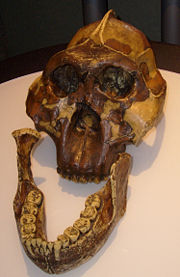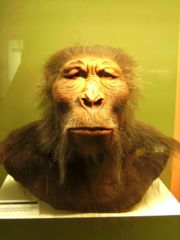- Australopithecus boisei
-
Paranthropus boisei Zeitraum Oberes Pliozän bis Pleistozän 2,1 bis 1,2 Mio. Jahre Fossilfundorte Systematik Altweltaffen (Catarrhini) Menschenartige (Hominoidea) Menschenaffen (Hominidae) Hominini Paranthropus Wissenschaftlicher Name Paranthropus boisei (Leakey, 1959) Paranthropus boisei (auch als Australopithecus boisei bezeichnet) war eine Hominiden-Art aus der Gattung Paranthropus innerhalb der Entwicklungslinie der Hominini. Er lebte vor etwa 2,1 bis 1,1 Millionen Jahren.
Er war Paranthropus robustus ähnlich, aber das Gesicht und die Backenzähne waren massiver. Die Größe des Gehirns betrug ungefähr 530 cm³. Paranthropus boisei war bis zu 1,50 Meter groß, wog etwa 40 bis 80 Kilogramm. Er besaß die größten Backenzähne aller Hominiden und wird daher auch „Nussknacker-Mensch“ genannt. Mit seiner kräftigen Kaumuskulatur, die an massiven Kieferknochen und an einem sagittalen Kamm ansetzte, konnte er härtere Pflanzennahrung wie Samen oder zähe Fasern zerkleinern.
Vor allem wegen des starken Gebisses zählt er - mit Paranthropus robustus und Paranthropus aethiopicus - zu den robusten Australopithecinen, die die meisten Forscher in die Gattung Paranthropus stellen. Er hatte wie alle „robusten“ Australopithecinen einen Scheitelkamm, an dem die mächtigen Kaumuskeln verankert waren. Seine Backenzähne waren 4 mal so groß wie die des heutigen Menschen (Homo sapiens). Einige Experten betrachten Paranthropus boisei und Paranthropus robustus als Varianten der gleichen Spezies. Offensichtlich hatte sich diese Art sehr stark an die gegebene ökologische Lebensnische spezialisiert und konnte sich dann, als die Verhältnisse sich änderten, nicht weiter anpassen. Nach aktuellem Forschungsstand gelten Paranthropus boisei / Paranthropus robustus als die letzten „robusten“ Vertreter der Australopithecinen und starben aus, ohne weitere Nachfolge-Arten zu hinterlassen.
Siehe auch
Rekonstruktion
von Paranthropus boisei
im Westfälischen Museum für Archäologie
Wikimedia Foundation.


